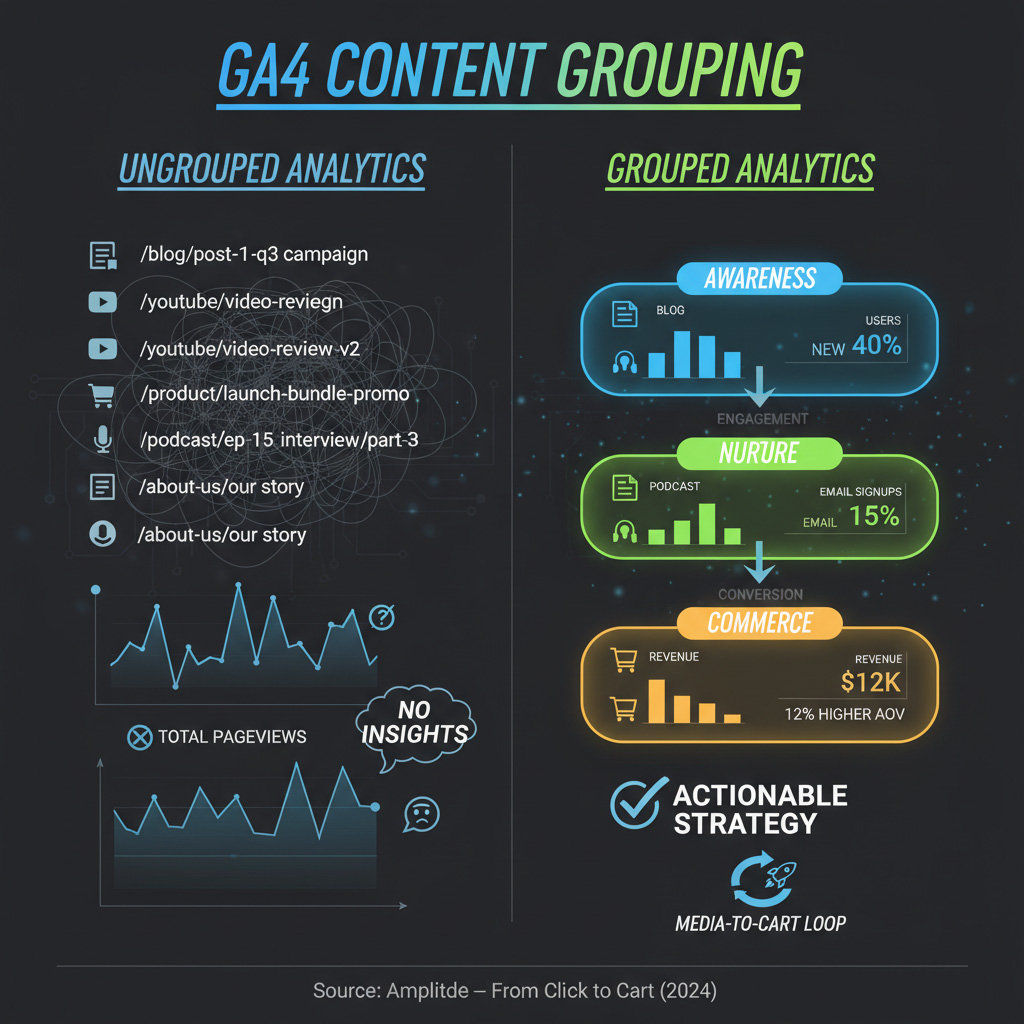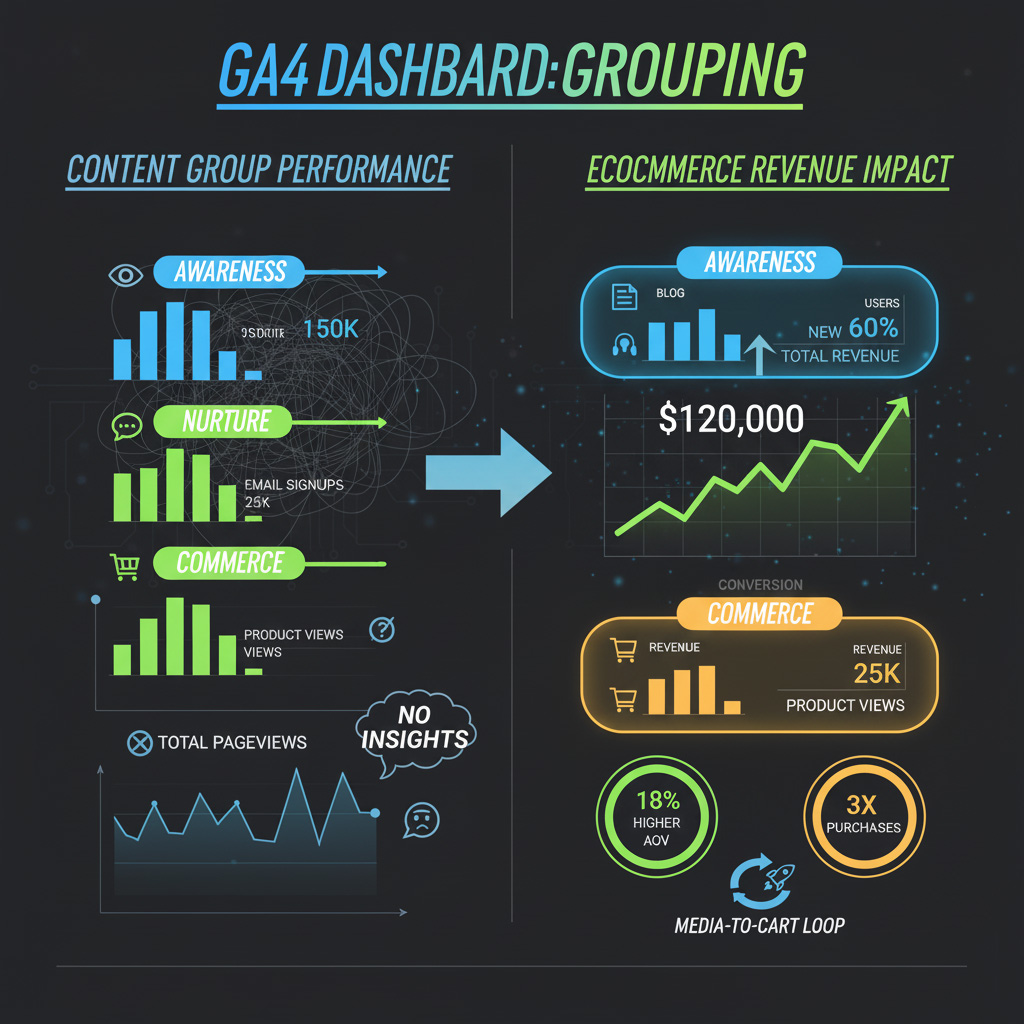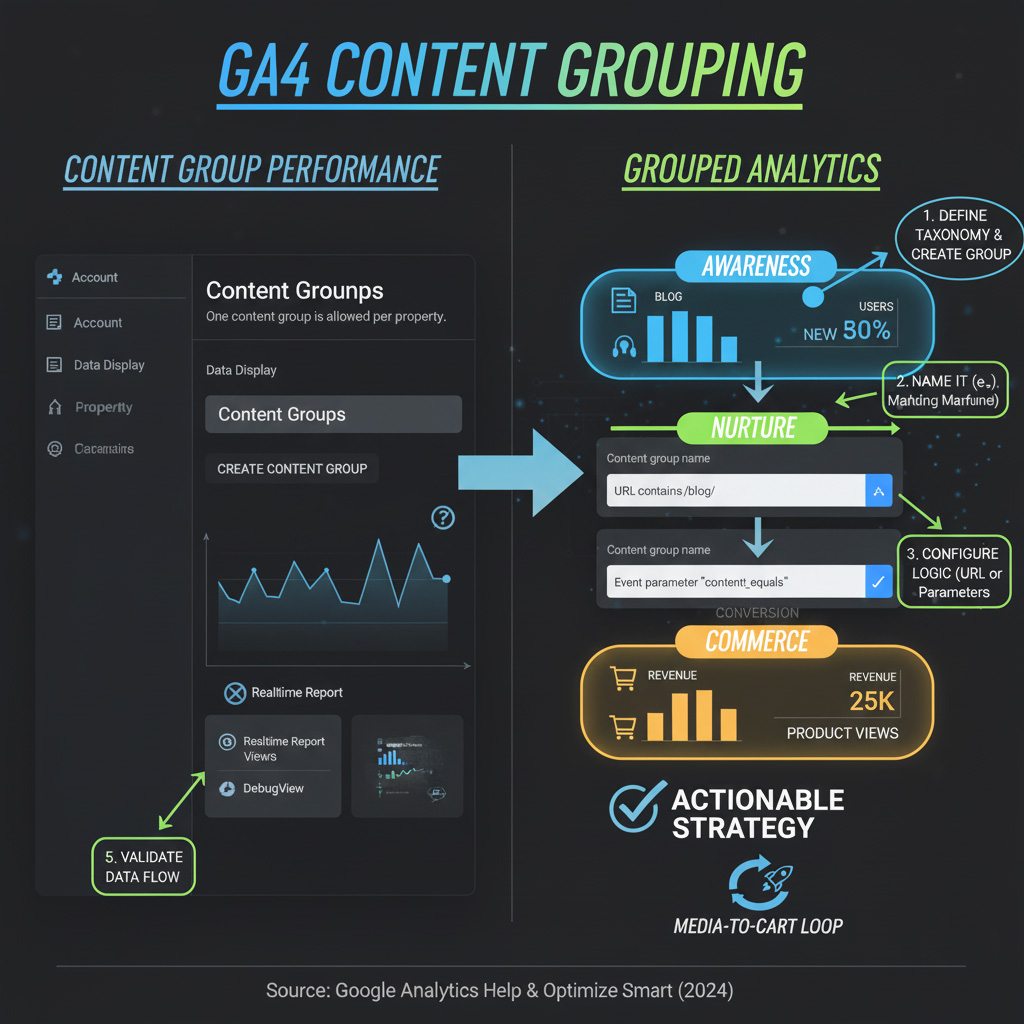Creative teams celebrate engagement. Operations tracks revenue and finds nothing.
Most brands still measure attention, not outcomes. According to Amplitude’s From Click to Cart report, 78 percent of customers use multiple channels before completing a purchase. Without structured analytics, that path is invisible.1
This guide explains how to use GA4 content grouping to connect creative work with commerce.
Table of contents
The Operator’s Problem: Views Without Visibility
Marketing tracks impressions. Operations tracks orders. Leadership sees a disconnect. The result is misaligned planning and creative teams chasing vanity metrics.
When analytics stop at clicks, decisions are made on instinct. Promo calendars drift. Budgets go to the loudest campaign, not the most profitable one. The core problem is that analytics measure activity, not impact. Until content data ties back to the cart, every metric is a guess.
Why GA4 Content Grouping Exists
GA4’s event model makes it possible to categorize assets. You can bucket them by type (video, blog, podcast) or by intent (awareness, nurture, conversion).
Google defines content grouping as “categorizing pages and screens into custom buckets.”2
Analytics Mania adds that content grouping “provides higher-quality insights compared to looking at pages individually.”3
What it enables:
- Compare performance across content formats in one property
- Trace how audiences move from content to checkout
- Build dashboards that align creative performance with revenue

The Payoff: Dashboards, Promo Cadence, and Predictable Media ROI
Once content is grouped, reporting becomes operational.
You can:
- Align content schedules with inventory and promotions
- Identify which themes lead to first-time purchases or subscriptions
- Forecast future performance based on past results
Example:
A wellness brand grouped its content by intent: educate, engage, convert. Within six weeks, “educate” pieces drove 40 percent of new email signups and those users had a 12 percent higher first-purchase rate. The team shifted resources toward that category before its next launch, improving return per hour of production.
Chartbeat’s research supports this connection: deeper engagement strongly predicts higher conversion rates.4

How to Implement GA4 Content Grouping
Step 1: Define Your Content Taxonomy
Decide how to classify your content. Use either type or intent, but not both at once. Limit to four to six groups. Document definitions in a shared sheet.
Step 2: Implement Custom Parameters
Add a parameter such as content_group to your GA4 event schema. Pass it automatically from your CMS or Google Tag Manager.
Step 3: Configure and Validate
In GA4 Admin, create your grouping logic using URL patterns or event parameters. Verify data in Realtime or DebugView to ensure it flows correctly.5
Step 4: Governance and Maintenance
Write down naming rules, ownership, and audit cadence. Review quarterly. Add new content types, check parameter consistency, and confirm dashboards still align.
Treat your taxonomy like a product schema that must stay clean.

Best Practices and Common Pitfalls
- Group by purpose, not by platform.
- Use names people can understand.
- Keep it simple. Precision matters more than granularity.
- GA4 allows only one content grouping per property. This limitation makes upfront taxonomy planning essential.6
- Once data becomes unreliable, teams stop trusting it.7
Keep governance tight to preserve trust.
Related read: Marketing Dashboard Metrics: How to Build Executive-Proof Dashboards
Key Takeaways
GA4 content grouping is analytics hygiene for modern operators.
It connects creative output to business results and turns reporting into a management tool instead of a scoreboard.
With consistent structure and upkeep, it forms the backbone of a working Media-to-Cart Loop—clarity replacing guesswork, decisions grounded in data, not noise.
FAQ
Universal Analytics allowed multiple groupings. GA4 allows one, but its event model is more flexible.
Yes, if both send events to GA4 with the same content_group parameter.
Quarterly or whenever a new format is introduced.
It doesn’t change the attribution model but makes top-funnel influence easier to interpret.
References
- https://info.amplitude.com/rs/138-CDN-550/images/From-Click-to-Cart.pdf ↩︎
- https://support.google.com/analytics/answer/11523339?hl=en ↩︎
- https://www.analyticsmania.com/post/content-groups-in-google-analytics-4/ ↩︎
- https://chartbeat.com/resources/research/content-attribution-conversions-analysis/ ↩︎
- https://www.optimizesmart.com/ga4-content-grouping/ ↩︎
- https://www.optimizesmart.com/ga4-content-grouping/ ↩︎
- https://info.amplitude.com/rs/138-CDN-550/images/From-Click-to-Cart.pdf ↩︎

